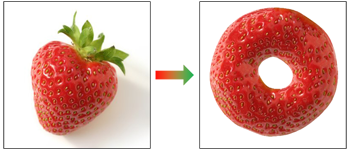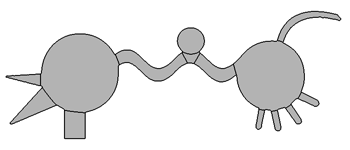(Work done with Edward H. Adelson and Marshall F. Tappen)
Puffball inflation is a tool which maps two-dimensional silhouettes to three-dimensional regions which have that silhouette as a planar cross-section. The video to the right describes how the Puffball inflation process works. Given a silhouette, Puffball begins by calculating the medial axis. The medial axis, developed by Harry Blum, is a central axial structure which runs through the middle of the shape and, in many cases, captures the apparent pereptual structure of the silhouette. It can be caclulated for any binary silhouette, and can be used to perfectly reconstruct the original silhouette. If one places circles of the appropriate radius along the medial axis, the union of these circles is the original shape. Puffball inflation uses this property to generate a three-dimensional shape. Instead of placing circles along the medial axis, Puffball places spheres; the union of these spheres is the Puffball inflation.
Though the process that calculates Puffball inflation is extremely simple (calculate the medial axis, place spheres along the medial axis, take the union) the results of the Puffball algorithm are highly intuitive and have many desirable properties. Puffball inflation is scale and shift-invariant, robust to perturbations in the contour of the silhouette, and can operate on any binary mask. In fact, because the operations of Puffball take place in image space, the most convoluted, topologically complex silhouette can be handled just as easily as the simplet circle; all silhouettes are treated as images, so complexity and topology have little to no effect on the performance of the algorithm.
Okay, so Puffball is a simple, reliable approach to the problem of inflation. So what? Inflation is an inherently ill-posed, ambiguous task that even the human visual system can't reliably perform. So why bother? Because it turns out that a simple, intuitive, scale invariant inflation tool can be surprisingly useful in a range of different vision and graphics tasks. For example...
Image-Based Material Transfer
An approach to surface texture and material synthesis which operates entirely in the image domain. Puffball provides a shape-based coordinate system which makes the approach possible.
Puffball Part Segmentation
A novel approach to locating parts in 2D silhouettes. Unlike previous approaches, which utilize contour curvature minima and mus solve the minima correspondence problem, our approach uses Puffball inflation to locate part boundary centers.






